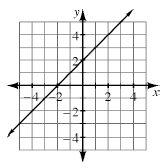y-coordinate
y-intercept

| A | B | C | D | E | F | G | H | IJK | L | M | N | O | P | Q | R | S | T | U | V | WXYZ | |
|---|---|---|---|---|---|---|---|---|---|---|---|---|---|---|---|---|---|---|---|---|---|
| Making Connections Glossary | |||||||||||||||||||||
x-axis |
|
|---|---|
| The horizontal number line on a coordinate grid. (See axis.) | |
x-coordinate |
|
| In an ordered pair, (p, q) , that represents a point in the coordinate plane, p is the value of the x-coordinate of the point. That is, the horizontal distance from the origin that is needed to plot the point. | |
x-intercept |
|
| The point(s) where a graph intersects the x-axis. A graph may have several x‑intercepts, no x-intercepts, or just one. It is sometimes reported that the x‑intercepts of a graph with coordinate pairs, but since the y-coordinate is always zero. Often just the x‑coordinates of x‑intercepts are given. (See y-intercept.) | |
y-axis |
|
| The vertical number line on a coordinate grid. (See axis.) | |
y-coordinate |
|
| In an ordered pair, (p, q) , that represents a point in the coordinate plane, q is the value of the y‑coordinate of the point. That is, the vertical distance from the origin that is needed to plot the point. | |
y-intercept |
|
The point(s) where a graph intersects the y-axis. A function has at most one y-intercept while a relation may have several. The y‑intercept of a graph is important because the y-intercept often represents the starting value of a quantity in a real-world situation. It is sometimes reported that the y-intercept of a graph with a coordinate pair, but since the x-coordinate is always zero, often just the y-coordinate of the y-intercept is given. For example, it may be said that that the y‑intercept of the graph at right is (0, 2) , or it may also be said that the y-intercept is 2. When a linear equation is written in y = mx + b form, b is the y-intercept of the graph. For example, the equation of the graph below is y = x + 2 and its y‑intercept is 2.
 |
|